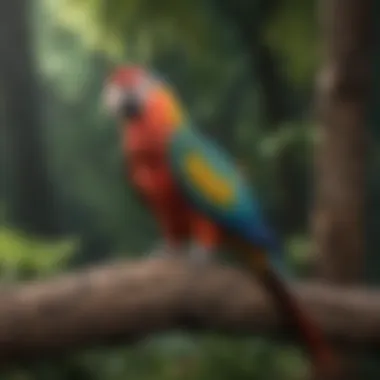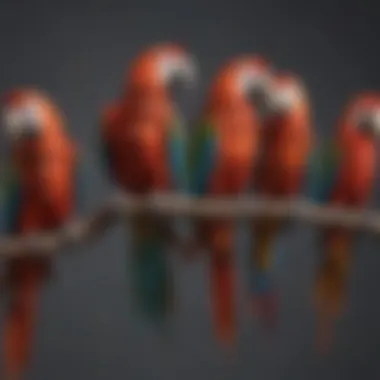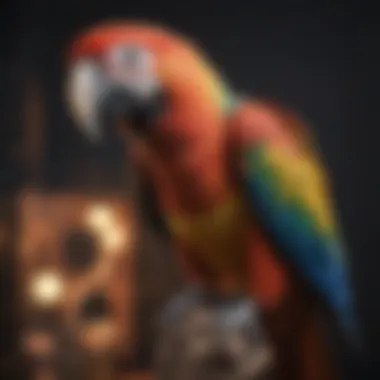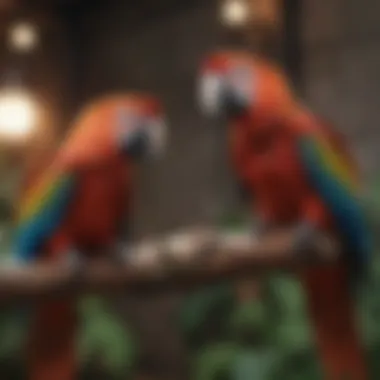Understanding Macaw Bird Perches: Essential Guide for Owners


Intro
Macaws are fascinating birds known for their vivid colors and engaging personalities. Their health and happiness greatly depend on their environment, particularly on perches. Understanding proper perch selection and maintenance can drastically improve a macaw’s life quality. In this guide, we explore essential aspects of macaw perches, analyzing materials, shapes, and sizes to suit the macaw's unique needs. Through effective management strategies, you can significantly impact your bird's behavior and overall well-being.
Care Tips
Daily Care Routines
Macaw perches need daily attention. Observe your bird as it interacts with its perch. Note any signs of wear or damage, which can affect the bird's comfort and safety. Ensuring that your macaw has easy access to their perch can encourage natural climbing and playing behavior.
Cage Setup and Maintenance
Choosing the right perch for your macaw cage is vital. A variety of perches of different diameters can promote foot health. Typically, wood perches are preferred as they mimic natural settings. Regularly check the stability of positioned perches.
Tips for a better setup:
- Utilize perches of multiple heights.
- Create space for flying paths within the cage.
- Ensure grips of perches vary in texture surfaces for increased adaptability.
Hygiene and Cleaning Practices
Cleanliness around perches plays a role in the macaw's overall health. Fecal matter and leftover food can lead to disease. Wipe down plastic or synthetic perches with safe disinfectants. It is a good practice to wash wooden and natural perches whenever needed, usually every week.
Seasonal Care Adjustments
Adapting perch setups to seasons can enrich a macaw’s environment. In summer, increase outdoor time if safe. In winter, ensure warmth near cages by repositioning perches if necessary.
Behavioral Insights
Understanding Bird Body Language
Macaws communicate their feelings through body language. Observe head posture or tail feather movements. These indicators can inform when the macaw is content or anxious.
Common Behavioral Issues and Solutions
Boredom can lead birds to engage in negative behaviors, like feather plucking. If your macaw displays these signs, reconsider which types of perches are available or how they interact with their environment.
- Natural wood branches can be better than straight wooden dowels.
- Enrich their setup for increased engaging activities.
Positive Reinforcement Techniques
When improving interactive play and exploration, use treats as positive reinforcement. Each time your macaw successfully uses a perch, reward with a favorite snack or attention.
Social Interaction Needs
Macaws are social beings. They thrive when given time with their owners or companions. Monitor how perches facilitate these interactions in your bird’s setup.
It’s crucial to provide a diverse and engaging environment to avoid behavioral issues.
Nutrition Guides
Macaw nutrition directly influences their energy levels and activity. Well-fed birds promote better interactions with their perches, staying agile in their habitat.
Essential Diet Components
Incorporate fresh fruits, vegetables, nuts, and quality pellets in their diet. Research species-specific requirements . Healthy eating contributes to better overall conditioning and therefore active perch use.
Safe and Toxic Foods
Understanding which foods are safe is as imperative as their daily meal schema. Avoid avocado, chocolate, and caffeine, as they are toxic.
Supplements and Treats
Consult with avian veterinarians for possible vitamin deficiency indications. Balanced treats should not replace staple foods but can enhance daily nutrition.
Feeding Strategies for Different Species


With a variety of macaw species, diets differ slightly in component balance. Look into the specific nutritional needs that map to your macaw's exact breed.
Preamble to Macaw Perches
In the world of macaw care, understanding perches is essential for providing an optimal living environment. Perches serve as the foundation for both physical comfort and emotional well-being. The choice of perch impacts everything from the bird’s foot health to its behavior. Well-chosen perches can foster exploration, play, and rest. Therefore, knowing how to select the right perches becomes critical for macaw owners.
The Significance of Perches in Macaw Care
Perches are not merely objects for birds to sit on; they significantly affect the macaw's lifestyle. They aid in exercise, toe movement, and play— key factors in the overall health of these intelligent creatures. Moreover, different textures and shapes stimulate the birds’ climbing instincts, fulfilling their need for exploration and physical activity. Without proper perches, macaws might face various health problems like foot injuries or boredom.
Furthermore, the right perch can foster better behavioral patterns. When macaws are comfortable and engaged, they exhibit fewer signs of stress. Ultimately, effective perch management supports a harmonious coexistence, enhancing both the owner’s experience and the bird’s happiness. "Good perch practices are part of holistic birdkeeping."
Understanding Macaw Behavior
Each macaw has a unique personality shaped by its environment. Their behavior largely depends on their habitat, which includes perches. These habitats are more than just a couple of wood pieces; they provide the necessary comfort for rest and security in their surroundings. By observing how your macaw interacts with its perch, you can understand its needs more clearly.
And remember, macaws enjoy variety, so mixing different types of perches encourages exploration. If they have numerous climbing options, they'll be more likely to stay mentally stimulated, reducing anxiety.
In summary, choosing the right perches is more than an aesthetic choice. It is crucial to the health, safety, and emotional well-being of your macaw.
Types of Perches for Macaws
Choosing the right type of perch is essential to foster the well-being of macaws. Their perches serve not just as a resting place but also play a crucial role in exercising their physical and mental facets. The material, shape, and diameter of the perches can significantly influence a bird's mood, health, and behavior. Let's explore the common types of perches used for macaws, each with specific advantages and drawbacks that owners should recognize.
Natural Wood Perches
Natural wood perches offer several benefits for macaws. They mimic what birds would experience in the wild, providing a tactile experience as well as various diameters and shapes.
Benefits of Natural Wood:
- Provides a natural feel similar to their environment.
- Varied texture helps in promoting foot health.
- Offers shapes that can enrich climbing and play.
- Unprocessed wood is safe, reducing possibilities of chemical exposure.
Considerations
Natural wood perches may require more maintenance, as they can harbor bacteria and fungi. Selecting appropriate varieties like manzanita or willow is critical. Monitoring for wear is crucial; replacing damaged wood avoids injury to the bird.
Synthetic Perches
Synthetic perches have gained popularity in the bird care industry. These involve materials such as plastic and rubber, often designed for easy cleaning and sanitation.
Advantages of Synthetic Perches:
- Easier to clean, maintaining a hygienic environment.
- Some products incorporate a non-slip surface, helping birds maintain grip.
- Often durable and resistant to breaking, which adds safety for active birds.
Drawbacks
These perches generally lack the natural texture that wood provides, potentially affecting a macaw's foot health. Owners should monitor the material for any signs of wear that can impact the surface texture.
Sandpaper Perches
Sandpaper perches present a unique option as they are usually considered useful for maintaining a macaw's nail health.
Key Features:
- They help trim nails naturally.
- Usually adheres to either wood or synthetic bases.
- Can be beneficial for foot hygiene when used appropriately.
Risks
However, there are concerns that continuous use can lead to foot injuries or discomfort. It is advisable to observe closely how birds respond to this type of perch. Sandpaper perches should not replace other perches; rather they are one component of an enriching substrates selection.
In summation, selecting the right type of perch involves balancing the health benefits with safety considerations. Through educated decisions, macaw owners will create a habitat that encourages physical vigor and daily engagement with their environment.
Factors Influencing Perch Selection
Selecting the right perches for macaws is crucial for the birds' comfort and health. The elements affecting perch selection include size, shape, texture, and material safety. Considering these factors helps in creating an environment where macaws feel secure and can thrive.


Size and Diameter Considerations
When choosing perches, size and diameter play critical roles. A perch must be appropriately sized to support the macaw's weight while accommodating its natural instincts. Ideally, the diameter of the perch should allow the macaw to grip it securely with its feet, often ranging from one to two inches depending on the size of the bird.
If the perch is too thin, it can lead to foot issues like bumblefoot, a condition that results from excessive pressure or friction on the feet. Conversely, a perch that is too thick can make it difficult for the macaw to grasp, impacting its comfort and balance. It is essential to offer a variety of perch sizes to allow for different gripping techniques. Various sizes encourage natural behavior, reflecting a range of habitats from which macaws originate.
Key Takeaway: Size and diameter must correspond with the specific needs of macaw species. Monitor their behavior to adjust accordingly.
Shape and Texture
Shape and texture are also essential aspects of perch selection. Macaws benefit from perches that vary in shapes such as round, flat, or even irregular. Round perches offer a natural grip, while flat surfaces may assist in balancing out the diet if they are connected to a feeding activity. Texture enhances the macaw's gripping ability and provides exercise for their feet.
Rougher surfaces mimic the branches of trees, allowing for more natural interaction. For example, a natural wood perch with its bark intact provides different textures that can encourage grooming behavior. This grooming promotes good foot health while preventing boredom. Smooth surfaces may cause slippage and be less enjoyable for the bird, making texture an important consideration.
Material Safety Considerations
Material safety is one of the most concerned priorities when selecting perches for macaws. The materials should be non-toxic and durable. Common choices include natural wood varieties like manzanita or pine, which present a sturdy support and are safe.
However, beware of treated woods, as they may harbor harmful chemicals. Synthetic materials like plastics can be beneficial but must be checked for resilience against chewing, which macaws are naturally prone to do. Perches made from concrete or rubbrized materials can also support foot health.
Regular checks for wear and fractures are necessary, as degraded materials can present injury risks. In summary, consider the sourcing of materials and research perches to ensure they are appropiate for the unique behavioral patterns of macaws.
In making choices on perch selection, understanding these factors allows for the enhancement of a macaw's habitat, contributing significantly to its happiness and health.
Perch Arrangement in the Aviary
Arranging perches within the aviary for macaws plays a crucial role in their engagement and well-being. Correct positioning of these essential elements impacts socialization, exercise, and overall health. The right arrangement fosters natural behaviors, allowing birds to explore and interact more freely. It's important to consider several specific aspects in creating an aviary that supports this vibrant species.
Optimal Heights for Perches
The height of perches can significantly influence how a macaw uses its space. Meduim and high perches help mimic their natural habitat where they would perch on tree branches. These heights enable flying or climbing down to lower levels. Hybrid heights provide social dynamics as macaws observe each other, promoting interactions. It's generally recommended to include perches at various heights. Birds prefer positions that they feel secure in, often higher locations.
Some important considerations include:
- Accessibility: Ensure that all heights are within reach for the macaws. Consider their size, movement and flying capability.
- Eye Level: Engage a bird's curiosity by allowing it to see other birds visually. This promotes healthier social interactions and exercise.
Creating Climbing Opportunities
Macaws are natural climbers. Providing an array of climbing opportunities enriches their environment and fulfillment. Utilize multi-leveled perches and rope ladders to facilitate movement. Changing textures and profiles, along with irregular spacing, encourages exploration.
Here are ways you can enhance climbing in aviaries:
- Use Natural Materials: Pieces of branches can provide a varied climbing experience with various diameters.
- Attach Climbable Features: Consider adding vines or hanging ladders using tightly tied ropes.
- Vertical Space: Maximizing vertical space in the aviary adds an opportunity for climbing that resembles their natural habitat.
Safety Precautions and Avoiding Hazards
The safety of macaws within their aviary is paramount. While arranging perches, its essential to avoid potential dangers that could disrupt their environment. Awareness of risks ensures a suitable habitat.
Some key safety tips include:
- Stability: Secure all perches tightly so they do not shake when a bird lands.
- Spacing: Maintain adequate distance between perches to avoid collisions while flying.
- Hazard Check: Routinely check perches and surrounding areas for sharp edges, loose materials or anything that cause injury.
Maintaining Perches for Health
Maintaining the health of your macaw entails not just considering diet or socialization but also prioritizing the condition of perches. Proper maintenance is integral for the shock absorption, comfort, and overall safety of your feathered companion. Dirty or worn-out perches can harbor bacteria, lead to injuries, and set back your bird's well-being. Thus, establishing a systematic routine for perch maintenance helps ensure a safe and healthy environment.
Cleaning and Disinfecting
Regular cleaning of macaw perches is essential. Perches can accumulate droppings, dust, and remnants from food, creating a breeding ground for harmful bacteria and parasites. The process involves many steps. First, remove any accessories or toys attached to the perch. Use an appropriate cleaner that is safe for birds; many pet stores sell avian-safe disinfectants.
After applying the cleaner, scrub the perch thoroughly. Pay special attention to crevices and joints where dirt may collect. Rinse well with clean water, ensuring no cleaning residue remains. Dry the perch completely before reintroducing it to the cage. It's advisable to clean perches at least once a week. If your bird shows any signs of health trouble, consider cleaning daily for a while.
Signs of Wear and Tear
Over time, even the most durable perch materials can show signs of deterioration. These signs need careful monitoring. Look for splintering wood, fraying synthetic materials, or fine cracks that may harbor pathogens. Also, any unequally worn surfaces can cause your macaw to struggle with grip, leading to potential foot injuries.


Regular inspections are crucial to recognize when a perch has reached the end of its safe usability. Catching these indicators early prevents accidents and promotes your bird’s comfort and safety.
Replacing Perches: When and How
Identifying when to replace a perch is a skill all macaw owners should develop. If signs of significant wear and tear are evident, replacement is needed immediately. It is better to opt for high-quality replacements, made with bird-safe materials. Understand the specific needs of your macaw when choosing new perches. Consider aspects such as diameter, texture, and compatibility with your bird's behavior.
When replacing a perch, ensure the new one is of appropriate height and secure it properly to avoid any risk of it falling. Test it for stability before allowing your macaw to use it. Revolve around on action orientations that keep your bird engaged and stimulate climbing and exploring.
In summary, maintaining the health of perches in your macaw's environment is a multifaceted task that requires vigilance and a proactive approach. Regular cleaning, keen observation, and timely replacement are the cornerstones for not just a safe space but an environment that nurtures the joyful spirit of your bird.
Enhancing Perches with Enrichment
Enhancing the experience of your macaw goes beyond just selecting the right perches. Incorporating enriching elements into their environment can have profound impacts on their physical and psychological well-being. Macaws are intelligent, curious animals. They thrive in dynamic environments where they can explore, play, and engage with their surroundings. Proper enrichment transforms otherwise simple perching stations into stimulating spaces that promote healthy behaviors among these birds.
**"Enrichment is not just beneficial; it is essential for the psychological health of macaws."
Adding Toys and Accessories
To maximize the functionality of perches, you should consider integrating toys and accessories. Perches, while serving as resting spots, can also become hubs of play if designed thoughtfully. Here are important elements to consider:
- Types of Toys: Use a variety of toys like foraging toys, chewable items, and hanging swings. Ensure these toys are bird-safe and tailored to withstand a macaw's strength.
- Interactive Experiences: Encourage your macaw to engage with their perch area through activities. This could include rotating new toys regularly or designing play areas that spark curiosity.
- Size and Accessibility: Place toys at varying heights and distances. This arrangement fosters natural play behavior, allowing your macaw to stretch, climb, and explore.
These additions can stimulate cognitive functions and relieve boredom, subsequently diminishing behaviors associated with stress.
Combining Perches with Other Features
An ideal perch can become a multifaceted area when combined with other features within the aviary or living space. Here's how to design an all-encompassing platform:
- Integrating Climbing Structures: Use varieties of perch heights and angles. It generates climbing opportunities fostering muscle development and overall well-being.
- Nearby Feeding Stations: Position feeding stations adjacent to perches to encourage foraging. This arrangement melds nutritional intake with physical activity, emulating a more natural feeding experience.
- Pools or Bathing Areas: Install areas nearby where macaws can bathe or perch while being misted. This promotes a more enriching experience, considering their enjoyment of water and grooming habits.
The careful design of your macaw's habitat using enrichment principles can provide not only comfort but also improved behavior. By enhancing perches thoughtfully, you support healthy habits and ensure your macaw remains active and entertained in a vibrant environment.
Expert Insights on Macaw Perches
Understanding the nuances of perch selection for macaws requires input from experienved professionals. This section contemplates teh insights of aviary veterinarians and bird owners who have developed knowledge through direct experience. Their observations serve as invaluable contributions, shedding light on how specific perch styles affect these exotic birds and support an informed selection process.
Interviews with Avian Veterinarians
Avian veterinarians provide crucial perspectives on the health and behavior of macaws in relation to their perches. In interviews, several veterinarians emphasize rarge aspects of perch management.
- What Do Vets Say About Perch Materials?: Many veterinarians suggest natural wood perches, as they mimic birds' natural habitats. Forests of the Amazon offer natural tangibles, which keep macaws physically and mentally stimulated. Often, vets advise ensuring that wood used is pesticide-free and non-toxic.
- Size Matters: Each macaw has a specific range in size and weight. Getting the appropriate diameter is key. Veterinary professionals believe a perch shape that promotes foot expansion is important to prevent foot problems.
- Positive Interaction: Documentation indicates that vet professionals have noted the direct correlation between perch arrangements and social behavior. Proper setup encourages interaction, assisting not just the mental well-being of birds but also fostering better relationships with their handlers.
"The choice of a perch can significantly affect a bird's health. It not only has physical dimensions but also impacts their opportunity for natural behaviors." – Dr. Molly Harrison, Avian Veterinaria
Furthermore, accurate guidance on cleaning routines, appropriate accessories, and durations for using different perches have become recurring themes among interviews. Simple recommendations save individuals from perennial pitfalls.
Case Studies from Experienced Bird Owners
Case studies are often reflective of realities that many aspiring or current bird keepers encounter. Learning about actual experiences maximizes comprehension and avoids unnecessary risks.
- Success Stories: A retired couple documented alterations in their macaws' behavior after swapping from smooth synthetic perches to natural wood variants. The birds demonstrated increased interest in climbing, playing, and socializing.
- Health Improvements: One documented incident covered a macaw owner who added a mineral perch. Veterinary findings showed that consistent use led to fewer occurrences of beak deterioration and foot fatigue. Birds seemed more energized and engaged.
- What Failed: Not all attempts lead to successes. For example, one owner tried a tough material that hindered machine bugginess – and birds simply refused to perch. Learning through failed methods emphasizes customized approaches to perch setup.
- Community Shared Experience: Various owners report sharing their wisdom on platforms such as reddit.com, highlighting how discussing specific perches with one another empowers more informed decisions.
Overall, insights from veterinarians along with anecdotal experiences from birds owners harmonize flaws in systems of understanding macaw habits. By aligning these findings, bird enthusiasts possess (lean of pressing) advantages in choices they make for the health and happiness of their companions.
Finale and Key Takeaways
The importance of this guide on macaw bird perches cannot be overstated. Perches play a crucial role in the physical and emotional health of macaws. Ensuring appropriate perch selection and maintenance can profoundly impact these birds’ behavior and well-being.
Summary of Essential Practices
To maintain the best conditions for macaws, bird owners should focus on several core practices. First, choose perches made from safe, non-toxic material. Natural wood perches often provide the most authenticity and stimulation for macaws. Additionally, ensure that the size and texture of the perches match the bird’s specific needs. Here are some key points to bear in mind:
- Safety First: Always prefer untreated wood, such as weathered pine or cedar, and avoid perches coated with harmful chemicals.
- Variety Matters: Provide a range of perch types. Mix and match sizes, shapes, and materials to create a stimulating environment.
- Regular Maintenance: Clean perches regularly to avoid disease and bacteria buildup. Inspect them frequently for signs of wear and tear.
These practices will help create a holistic environment that caters to the macaw's psychological and physical festivity.
Future Considerations for Bird Owners
As you continue your journey as a bird owner, consider emerging trends and research in avian care. Staying informed will enhance the living conditions for your macaw:
- Innovative Perch Designs: Look out for new perch products that focus on ergonomic benefits and food accessibility.
- Environmental Enrichment: As you learn, consider opportunities to enrich your macaw’s habitat beyond standard perches. This includes interaction with toys or climbing spaces.
- Behavioral Studies: Pay attention to studies about parrot behavior that can offer insights related to perch use and overall well-being.
Staying current empowers you to make knowledgeable choices that enrich the relationships with your feathered companion.















